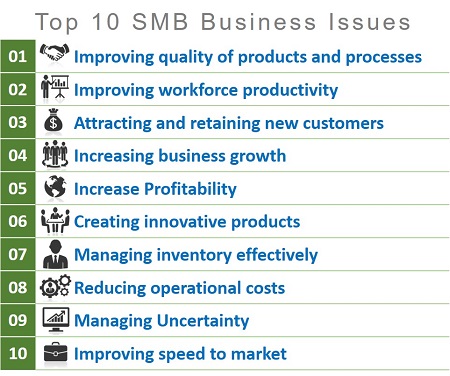Cloud is clearly established within the US SMB market, in a way that is unique in the global context: nowhere else have the vast majority of SMBs leapt into the cloud. Cloud is also gaining acceptance in Asia/Pacific, Europe & even in Middle-East, regions where Cloud is being seen by SMBs as solving real-world business problems. But most suppliers are peddling their technology assets, focusing on non-viable channel relationships & showcasing wrong-sized solutions for workloads that have very short acquisition & deployment time window.
Techaisle Blog
The first step in understanding if a particular type of technology will be important to a market is to understand why it might be important: how can the technology meaningfully address the business needs within the target community? This begs in turn a more fundamental question – what are these needs?
Techaisle’s recent SMB Cloud Adoption survey shows that the top ten business issues identified by SMBs align with well-recognized cloud attributes or applications. For example, cloud is seen as a way of delivering improved automation to a very wide range of functions, within IT and across the business as a whole; these solutions improve processes, which in turn will improve production and support of products. Cloud also supports key collaborative technologies (notably, mobility and file exchange), which have a positive impact on productivity, and cloud is viewed as the primary platform for ‘systems of engagement’ that help businesses attract and retain new customers. Cloud encompasses many different types of offerings, which deliver benefits that align with SMB needs.

Similar observations are made regarding the challenges faced by small and midmarket businesses.
In today’s SMB market, it is critical for vendors to build detailed understanding of the small and midmarket segments, and to align resources and strategies with requirements as SMBs move from initial experimentation with sophisticated solutions towards mass-market adoption.
In its latest study, Techaisle analyzes 1,116 survey responses to provide the insight needed to build and execute on cloud solution strategies for the small and midmarket customer segments. Techaisle’s deep understanding of SMB IT and business requirements enables vendors to understand the ‘why’ and ‘when’ of solution adoption, current and planned approaches to solution use, the benefits that drive user investments, and key issues in aligning with buyers and building and intercepting demand.
Highlights of findings presented in the report include:
Candid conversation with Dell Cloud-Client Computing chief strategist
Jeff McNaught, Executive Director & Chief Strategy Officer, Dell Cloud Client-Computing and co-inventor of Wyse thin client had a candid conversation with Techaisle on his new product initiatives, focus on security, building solutions for small and medium businesses and renewed attention to channel partners. Jeff is deeply involved in software solutions which includes partner software - Citrix, Microsoft and VMware and is responsible for the cloud-client business which includes devices that Dell build’s exclusively for Citrix or VMware as well as new products and software security offerings. One of his major new initiatives includes simplifying and securing virtual workspaces better than anyone else.
Dell VDI converging on security, cost, complexity and channels
Based on extensive primary research with SMBs and the channel partners, Techaisle forecasts the US SMB VDI market to be US$13 billion in 2020 as VDI penetration increases to 34 percent from the current 26 percent and an increase in number of seats from users who have already deployed VDI. Most of the midmarket firms that have invested in VDI are still experimenting with the technology, and most small businesses are still several years away from even this level of preliminary adoption.
The allure of VDI is clear – but the technology itself and the path to realizing its benefits is still mysterious to many small and midmarket businesses. Techaisle research shows that there is a need for VDI vendors to embark on a messaging exercise that includes - real-world examples of successful deployment of VDI, ease of VDI implementation with the least pain for SMBs & simplification of understanding VDI technology by removing fear and complexity.
Over the last two years Dell has been trying to build a momentum to remove the mystery and reduce deployment complexity. Along the way it has had more successes than missteps and it seems that Dell has reached a stage where it reasonably understands the needs of the end-customers and how to work with channel partners to win business and deploy solutions. Dell has architected multiple VDI solution delivery models for SMBs of all sizes and levels of technology adoption.












